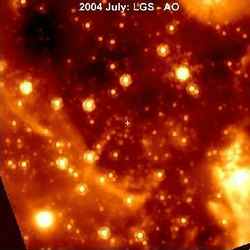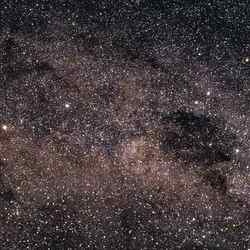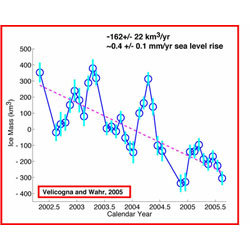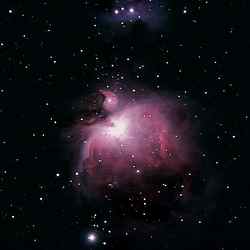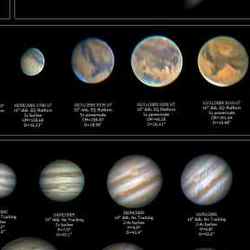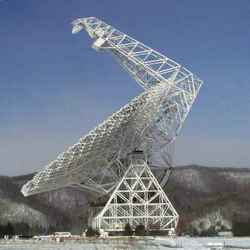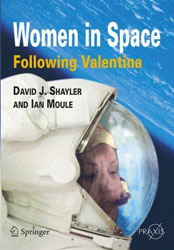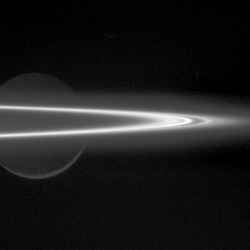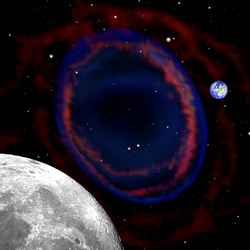
An artist’s concept of a hypothetical supernova in our galaxy. Image credit: David A. Aguilar (CfA). Click to enlarge
A team of astronomers has found faint visible echoes of three ancient supernovae by detecting their centuries-old light as it is reflected by clouds of interstellar gas hundreds of light-years removed from the original explosions.
Located in a nearby galaxy in the southern skies of Earth, the three exploding stars flashed into short-lived brilliance at least two centuries ago, and probably longer. The oldest one is likely to have occurred more than six hundred years ago.
The light echoes were discovered by comparing images of the Large Magellanic Cloud (LMC) taken years apart. By precisely subtracting the common elements in each image of the galaxy and looking by eye to see what variable objects remain, the team looked for evidence of invisible dark matter that might distort the light of stars in a transitory way, as part of a sky survey called SuperMACHO.
This careful image analysis also revealed a small number of concentric, circular-shaped arcs that are best explained as light moving outward over time, and being scattered as it encounters dense pockets of cool interstellar dust. Team members then fit perpendicular vectors to the curves of each arc system, which were found to point backwards toward the sites of three supernovae remnants, which were previously known and thought to be relatively young.
“Without the geometry of the light echo, we had no precise way of knowing just how old these supernovae were,” said astronomer Armin Rest of the National Optical Astronomy Observatory (NOAO), lead author of a paper on the discovery in the December 22, 2005, issue of Nature. “Some relatively simple mathematics can help us answer one of the most vexing questions that astronomers can ask-exactly how old is this object that we are looking at?”
Just as a sound echo can occur when sound waves bounce off a distant surface and reflect back toward the listener, a light echo can be seen when light waves traveling through space are reflected back toward the viewer-in this case, the Mosaic digital camera on the National Science Foundation’s Blanco 4-meter telescope at Cerro Tololo Inter-American Observatory (CTIO) in Chile.
This technique can be extended to famous supernovae in history. “Imagine seeing light from the same explosion first seen by Johannes Kepler some 400 years ago, or the one recorded by Chinese observers in 1006,” said Christopher Stubbs of the Harvard-Smithsonian Center for Astrophysics (CfA), co-author of the paper and principal investigator for the SuperMACHO program. “These light echoes give us that possibility.”
In principle, astronomers can split the light echo into a spectrum to investigate what type of supernova occurred. “We have the potential with these echoes to determine the star’s cause of death, just like the archaeologists who took a CT scan of King Tut’s mummy to find out how he died,” said co-author Arti Garg of CfA.
Astronomers can also use supernova light echoes to measure the structure and nature of the interstellar medium. Dust and gas between the stars are invisible unless illuminated by some light source, just as fog at night is not noticeable until lit by a car’s headlights. A supernova blast can provide that illumination, lighting up surrounding clouds of matter with its strobe-like flash.
“We see the reflection as an arc because we are inside an imaginary ellipse, with the Earth at one focus of the ellipse and the ancient supernovae at the other,” explained Nicholas Suntzeff of NOAO. “As we look out toward the supernovae, we see the reflection of the light echo only when it intersects the outer surface of the ellipse. The shape of the reflection from our vantage point appears to be a portion of a circle.”
An unusual aspect of the arcs is that they generally appear to move much faster than the speed of light. This does not violate the cosmic speed limit, which states that any object cannot move faster than the speed of light. “What our telescopes see is the reflection moving, and not any physical object,” Suntzeff added. “It is also very exciting that our observations confirm the visionary prediction of Fritz Zwicky in 1940 that light from ancient supernovae could be seen in echoes of the explosion.”
Two additional high-resolution color graphics to illustrate this result are available at http://www.noao.edu/outreach/press/pr05/pr0512.html.
Other co-authors of the Nature paper are Knut Olsen and Chris Smith (CTIO); Jose Luis Prieto (Ohio State University); Douglas Welch (McMaster University, Ontario); Andrew Becker and Gajus Miknaitis (University of Washington); Marcel Bergmann (Gemini Observatory); Alejandro Clocchiatti and Dante Minniti (Pontifica Universidad Catolica de Chile); and, Kem Cook, Mark Huber and Sergei Nikolaev (Lawrence Livermore).
Headquartered in Cambridge, Mass., the Harvard-Smithsonian Center for Astrophysics (CfA) is a joint collaboration between the Smithsonian Astrophysical Observatory and the Harvard College Observatory. CfA scientists, organized into six research divisions, study the origin, evolution and ultimate fate of the universe.
Original Source: CfA News Release

